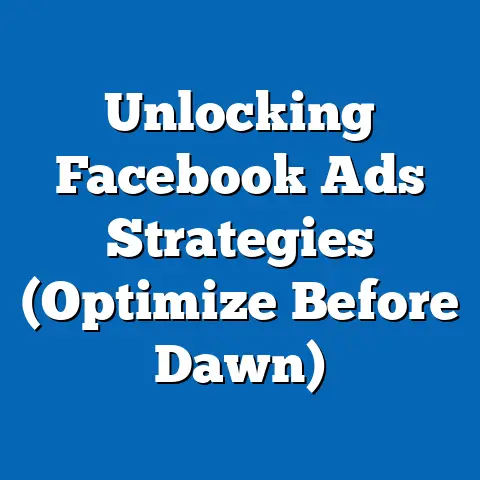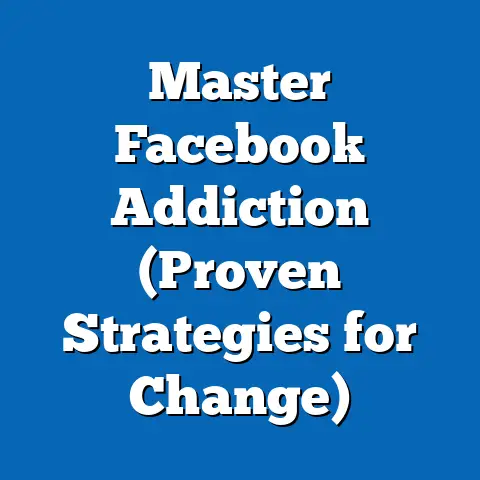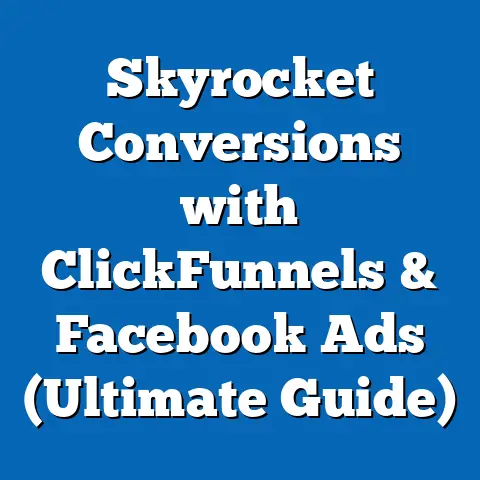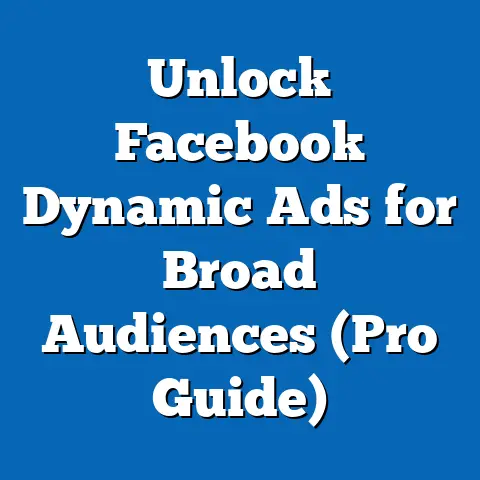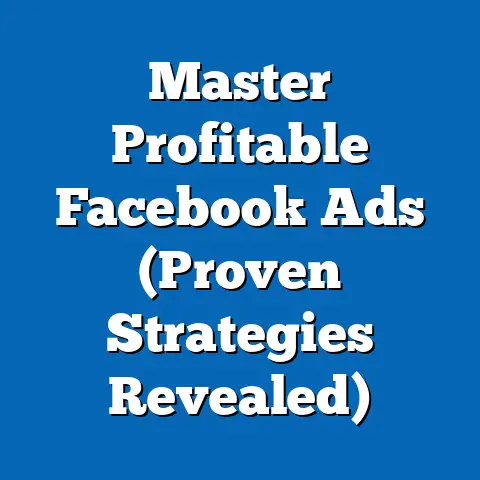Unlock Profitable Amazon Plots for Facebook Ads (Maximize ROI)
As a digital marketer, I’m always on the lookout for that edge – that one strategy that can significantly boost ROI and set campaigns apart. One thing I’ve learned over the years is that the best ideas often come from unexpected places. And when it comes to Facebook advertising, one of the most overlooked goldmines is sitting right under our noses: Amazon.
Think about it. Amazon is a treasure trove of consumer data, product insights, and market trends. It’s a place where millions of people actively search for and purchase products every single day. By tapping into this vast resource, we can dramatically improve our Facebook ad campaigns, leading to higher engagement rates, increased conversions, and ultimately, a much better return on investment.
Many advertisers are missing out on this simple yet powerful strategy. They create Facebook ads in a vacuum, without leveraging the wealth of information available on Amazon. This is like trying to navigate a maze blindfolded. But with the right approach, we can use Amazon to illuminate the path to success.
In this guide, I’ll walk you through how to unlock profitable Amazon plots for your Facebook ads, showing you how to leverage Amazon’s data and insights to create highly targeted, effective campaigns that drive real results. Let’s dive in!
Understanding the Relationship Between Amazon and Facebook Ads
The synergy between Amazon and Facebook is undeniable, but it’s often underestimated. Amazon is a powerhouse of e-commerce, with a vast amount of consumer data that can be incredibly valuable for enhancing targeting on Facebook. Think of it this way: Amazon knows what people are buying, searching for, and even reading reviews about. This provides a comprehensive understanding of consumer behavior that can be directly translated into effective advertising strategies on Facebook.
One of the key reasons this relationship works so well is that both platforms cater to different stages of the customer journey. Amazon is often the final destination, where the purchase happens. Facebook, on the other hand, is often where the customer’s journey begins, sparking initial interest and awareness. By aligning our strategies across both platforms, we can create a seamless and highly effective marketing funnel.
The Importance of Understanding Consumer Behavior on Amazon
Understanding consumer behavior on Amazon is crucial because it provides insights into what motivates people to buy. What problems are they trying to solve? What features are they looking for? What pain points are they trying to avoid? By analyzing customer reviews, product rankings, and best-seller lists, we can gain a deep understanding of consumer needs and preferences.
For example, let’s say you’re selling a kitchen gadget. By reading Amazon reviews, you might discover that customers are frustrated with similar products that are difficult to clean. This insight can then be used to craft Facebook ad copy that highlights the easy-to-clean features of your product, directly addressing a key customer pain point.
Case Studies: Integrating Amazon and Facebook for Success
To illustrate the power of integrating Amazon and Facebook, let’s look at a few examples:
- Example 1: A Fitness Apparel Brand: This brand used Amazon’s best-seller lists to identify trending workout clothes. They then created Facebook ads targeting specific demographics interested in those trends, resulting in a 30% increase in click-through rates and a 20% boost in sales.
- Example 2: A Home Decor Company: This company analyzed Amazon customer reviews to understand what customers loved and hated about existing products. They used this feedback to create Facebook ads that highlighted the unique features of their products, directly addressing customer concerns. This resulted in a 40% increase in engagement and a 25% increase in conversions.
- Example 3: An Electronics Retailer: By monitoring customer search terms on Amazon, they identified a rising demand for noise-canceling headphones. They launched a Facebook ad campaign targeting audiophiles and frequent travelers, emphasizing the superior noise-canceling capabilities of their product. This led to a 50% increase in website traffic and a 35% jump in sales.
These examples demonstrate how leveraging Amazon’s data can lead to more targeted and effective Facebook ad campaigns.
Takeaway: By understanding the synergy between Amazon and Facebook and leveraging Amazon’s consumer data, we can create more effective and profitable Facebook ad campaigns.
Identifying Profitable Niches on Amazon
One of the first steps in unlocking profitable Amazon plots for Facebook ads is identifying the right niches. Not all products are created equal, and some niches are simply more lucrative than others. By conducting thorough market research on Amazon, we can identify trending products and niches with high potential for conversion.
Market Research on Amazon: Finding Trending Products
Amazon is a goldmine of market data. To start, I’d suggest using Amazon’s search bar as a starting point. Typing in generic terms related to your product category can reveal auto-suggested keywords that are currently trending. These suggestions reflect what other users are actively searching for, offering a real-time snapshot of popular interests.
Here’s a tip I often use: Pay attention to the “Customers who bought this item also bought” section on product pages. This area provides valuable cross-selling opportunities and insights into what complementary products customers are interested in. It’s like getting a sneak peek into their shopping cart!
Tools and Methods for Analyzing Amazon Data
To dive deeper, there are several tools and methods we can use:
- Amazon Best-Seller Lists: These lists provide a snapshot of the top-selling products in various categories. By analyzing these lists, we can identify trending products and niches with high demand.
- Customer Reviews: Customer reviews are a treasure trove of information. By reading reviews, we can understand what customers love and hate about existing products. This can help us identify unmet needs and opportunities to differentiate our products.
- Product Rankings: Product rankings provide insights into the popularity and visibility of different products. By tracking product rankings, we can identify products that are gaining traction and those that are losing popularity.
- Third-Party Tools: There are several third-party tools available that can help us analyze Amazon data. These tools can provide insights into keyword rankings, sales estimates, and competitor analysis. Some popular options include Jungle Scout, Helium 10, and Viral Launch.
Selecting Products with High Conversion Potential
When selecting products to promote through Facebook ads, it’s important to focus on those with high conversion potential. This means selecting products that are in demand, have positive reviews, and offer a unique value proposition. I like to look for products that solve a specific problem or offer a significant benefit to the customer.
For example, if you’re selling a kitchen gadget, look for products that address a common pain point, such as difficulty cleaning or lack of durability. By highlighting these features in your Facebook ads, you can increase the likelihood of conversion.
Takeaway: By conducting thorough market research on Amazon, we can identify profitable niches and select products with high conversion potential for our Facebook ad campaigns.
Crafting Compelling Facebook Ads Based on Amazon Insights
Once we’ve identified the right products to promote, the next step is to craft compelling Facebook ads that capture attention and drive conversions. This means creating ad copy and visuals that are both engaging and relevant to our target audience, drawing inspiration from successful Amazon listings.
Elements of Effective Facebook Ad Copy and Visuals
When crafting Facebook ad copy, it’s important to focus on the benefits of the product, rather than just the features. What problem does the product solve? What value does it offer to the customer? Use strong, persuasive language that resonates with your target audience.
Here’s a tip: Borrow phrases and keywords directly from Amazon product titles and descriptions. This ensures that your ad copy is aligned with what customers are already searching for.
For example, instead of saying “Our kitchen gadget is made of stainless steel,” try saying “Say goodbye to messy cleanups with our easy-to-clean stainless steel kitchen gadget.”
When it comes to visuals, it’s important to use high-quality images and videos that showcase the product in action. Use images that are clear, well-lit, and visually appealing. If possible, use videos to demonstrate how the product works and highlight its key features.
Integrating Amazon’s Customer Feedback and Product Features
One of the most effective ways to craft compelling Facebook ads is to integrate Amazon’s customer feedback and product features into your ad content. This means highlighting the features that customers love and addressing any concerns that they may have.
For example, if customers are raving about the durability of a product, highlight that in your ad copy. If customers are complaining about the difficulty of cleaning a similar product, emphasize the easy-to-clean features of your product.
Examples of High-Performing Ad Formats
There are several different ad formats that can be used to showcase Amazon products on Facebook. Some of the most popular options include:
- Carousel Ads: Carousel ads allow you to showcase multiple products in a single ad. This is a great option for showcasing a range of products or highlighting different features of a single product.
- Video Ads: Video ads are a great way to capture attention and demonstrate how a product works. Use videos to showcase the product in action and highlight its key features.
- Collection Ads: Collection ads are a mobile-first ad format that allows you to showcase a collection of products in a visually appealing way. This is a great option for showcasing a curated collection of products or highlighting a specific theme.
- Single Image Ads: Simple and effective, single image ads can be powerful when paired with compelling copy and a clear call to action.
Takeaway: By crafting compelling Facebook ads that draw inspiration from successful Amazon listings, we can capture attention and drive conversions.
Targeting Strategies for Facebook Ads Using Amazon Data
Targeting is the cornerstone of any successful Facebook ad campaign. By leveraging Amazon data, we can create highly targeted audiences that are more likely to convert. This means going beyond basic demographics and interests and diving into the specific behaviors and preferences of Amazon customers.
Advanced Targeting Strategies Using Amazon Demographics and Interests
Amazon provides a wealth of data about its customers, including their demographics, interests, and purchase history. We can use this data to create highly targeted audiences on Facebook.
For example, if you’re selling a product that appeals to a specific demographic, such as millennials, you can target Facebook users who are in that age range and have shown an interest in related topics, such as technology, travel, or fashion.
You can also target Facebook users who have purchased similar products on Amazon. This is a great way to reach potential customers who are already interested in your product category.
Creating Lookalike Audiences Based on Amazon Customer Profiles
One of the most powerful targeting strategies is to create lookalike audiences based on your existing Amazon customer profiles. Lookalike audiences are Facebook users who share similar characteristics and behaviors with your existing customers.
By creating lookalike audiences, you can reach a wider audience of potential customers who are more likely to be interested in your products.
To create a lookalike audience, you’ll need to upload a list of your Amazon customers to Facebook. Facebook will then analyze this list and identify users who share similar characteristics and behaviors.
Pixel Tracking and Retargeting Strategies
Pixel tracking and retargeting are essential for converting potential buyers who have shown interest in your Amazon listings. By installing the Facebook pixel on your Amazon product pages, you can track the actions that users take on your site, such as viewing a product or adding it to their cart.
This data can then be used to create retargeting ads that are shown to users who have previously interacted with your Amazon listings. For example, you can show retargeting ads to users who have viewed a specific product but haven’t added it to their cart.
Retargeting ads are highly effective because they target users who are already interested in your products. This increases the likelihood of conversion.
Takeaway: By leveraging Amazon data to create highly targeted audiences, we can increase the effectiveness of our Facebook ad campaigns and drive more conversions.
Measuring Success and Optimizing Campaigns
Measuring the success of our Facebook ad campaigns is crucial for understanding what’s working and what’s not. By tracking key performance indicators (KPIs), we can identify areas for improvement and optimize our campaigns for maximum ROI.
Key Performance Indicators (KPIs) to Track
There are several KPIs that we should track to measure the success of our Facebook ad campaigns. Some of the most important include:
- Click-Through Rate (CTR): The percentage of users who click on our ad after seeing it.
- Conversion Rate: The percentage of users who complete a desired action, such as making a purchase, after clicking on our ad.
- Cost Per Click (CPC): The amount we pay each time someone clicks on our ad.
- Cost Per Acquisition (CPA): The amount we pay each time someone completes a desired action, such as making a purchase.
- Return on Ad Spend (ROAS): The amount of revenue we generate for every dollar we spend on advertising.
A/B Testing for Maximum ROI
A/B testing is an essential part of optimizing our Facebook ad campaigns. By testing different ad creatives and targeting options, we can identify what works best for our target audience.
For example, we can test different headlines, images, and calls to action to see which ones generate the most clicks and conversions. We can also test different targeting options to see which ones reach the most relevant audience.
Interpreting Data and Making Informed Adjustments
The final step in measuring success and optimizing our campaigns is to interpret the data and make informed adjustments. This means analyzing our KPIs and identifying areas for improvement.
For example, if our CTR is low, we may need to improve our ad copy or visuals. If our conversion rate is low, we may need to improve our product page or checkout process. If our CPA is high, we may need to adjust our targeting options or bidding strategy.
By continuously monitoring our KPIs and making informed adjustments, we can optimize our Facebook ad campaigns for maximum ROI.
Takeaway: By tracking key performance indicators (KPIs) and A/B testing different ad creatives and targeting options, we can optimize our Facebook ad campaigns for maximum ROI.
Conclusion
In this guide, I’ve shared some of the key strategies for unlocking profitable Amazon plots for your Facebook ads. By leveraging Amazon’s data and insights, we can create highly targeted, effective campaigns that drive real results.
Remember, the key to success is to understand the synergy between Amazon and Facebook, conduct thorough market research, craft compelling ad copy and visuals, create highly targeted audiences, and continuously monitor and optimize your campaigns.
By implementing these strategies, you can unlock profitable advertising opportunities on Facebook and maximize your ROI.
Call to Action
Now it’s your turn! I encourage you to take action by implementing the strategies outlined in this article to enhance your Facebook ad campaigns.
Have you had success using Amazon insights to improve your Facebook ads? Share your experiences in the comments below!
If you’re looking for personalized advice on enhancing your ad strategies, feel free to reach out. I’m always happy to help fellow marketers achieve their goals.


